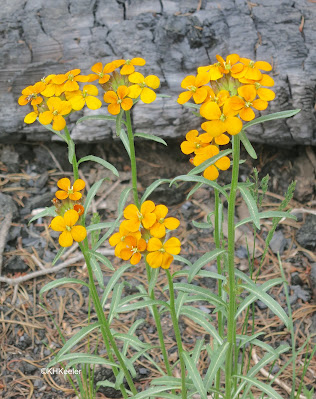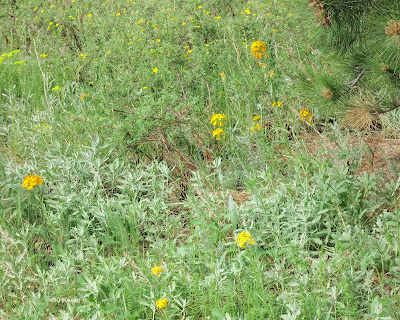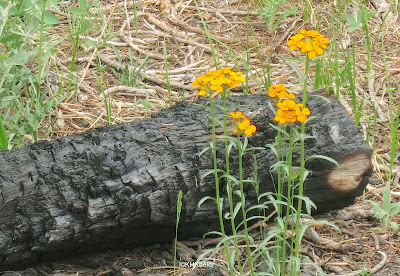 |
| western or sanddune wallflower, Erysimum capitatum |
 |
| western wallflower |
Erysimum is a Northern Hemisphere genus of 150 species. The most species are found in Eurasia but 13 species are native to North America. Three native species, western wallflower E. asperum, sanddune wallflower, E capitatum, and the shy wallflower, E. inconspicuum, and two introduced species, Siberian wallflower or wormseed wallflower, E. chieranthoides, and the spreading wallflower, E. repandum, are found all across North America. The other 10 native species and 6 naturalized from elsewhere in the world, are restricted to a few states or provinces. None of the wallflowers, although widespread and weedy, are considered problem weeds.
Wallflowers are short-lived plants. Some species are strictly annual, but most live two to a few years. They grow to about two feet high and are covered with golden (or yellow or deep orange) flowers in late spring. The flowers can be an inch in diameter. They develop curious long thin seed pods (siliques). I rarely see more than one at a time, but some places in the West you can encounter a patch of wallflower plants, all intensely yellow-orange and a-flutter in butterflies. The flowers have a pleasant scent and are very attractive to butterflies.
 |
| western wallflower with developing fruit (the odd curvy stalks) |
The name wallflower comes from Europe. There, the common wallflower is a plant that grows particularly well on old rock walls or rocky hillsides. That doesn't apply to American wallflowers--they grow in meadows or forest gaps--but the name stuck. Very probably the term wallflower for a shy person came from Europeans describing shy people hiding back along the wall, "like a wallflower." That seems odd in North America where the wallflower is a very bright conspicuous plant. Part of that image carries over for me, though; I think of wallflowers of well-behaved, quiet, attractive plants.
 |
| wallflower in Rocky Mountain National Park |
Linnaeus gave them the scientific name Erysimum based on the Greek word eryso "to ward off or heal" because European wallflowers were minor medicines, or possibly from eryo "to drag," explanation not given.
Some years ago, botanists separated European wallflowers from the North American ones, putting the European species into a new genus Cheirathus and leaving the American species in Erysimum. More recently, the differences between Cheiranthus and Erysimum didn't withstand DNA analysis and so all the Cheiranthus species are now in the genus Erysimum again. Not everyone accepted this change, so contradictory authoritative statements are easy to find. My reading of the name websites (Kew's Checklist of Vacular Plants, World Flora Online) is that the genus Cheiranthus no longer exists; all the Cheiranthus species should be Erysimum species. There are other confusions, though. For example, GBIF's species names don't match Kew's, let alone the names you see on nursery and garden shop websites. Apparently the world wide genus Erysimum needs thorough study; the very similar flowers, the need for seed pods as well as flowers for identification, and the tendency to hybridize make them very difficult, and that extensive study has not yet been done.
 |
| western wallflowers in a mountain meadow |
Even the common names are difficult. Western wallflower is both Erysimum asperum and E. capitatum. The USDA plants data base calls the E. asperum western wallflower and E. capitatum sanddune wallflower--despite the fact that E. capitatum is found in California, Oregon, and Nevada and E. asperum doesn't get to those western states. Other sources, such as the U.S. Forest Service, call E. capitatum western wallflower. Looking at the distribution maps, Erysimum asperum is the eastern and plains "western wallflower" and the flowers are generally yellow. Erysimum capitatum is the Rocky Mountain and westward "western wallflower" and its flowers can be quite orange, yellow, or purplish-pink. (There are a series of more technical differences, look, for example, at the Flora of Colorado for how to distinguish them in their states of overlap.)
 |
| western wallflowers, E. capitatum, two years after a forest fire |
As natives they are hosts to the larvae of a variety of butterflies and moths. That is expected for a widespread native species but the only host insect I could find a name for was the Pacific orangetip, Anthocharis sara, of the Pacific coast. The cabbage white, Pieris rapae, generalist on mustards, included Erysimum and E. capitatum among its list of host plant on a couple of websites (Host Plants by Butterfly Species, Desert Survivors). I could not find other specifics about lepidoptera that feed on wallflowers.
Wallflowers appear to have diversified worldwide because, in addition to the mustard oils characteristic of their plant family, they evolved to produce cardiac glycosides. Cardiac glycosides block channel function in muscle cells, including heart muscle; they are nasty, quite toxic compounds. This is why several insects that routinely eat mustards, some cabbage butterflies, genus Pieris, for example, don't eat wallflowers. This doesn't seem to have stopped lots of beetles and gall insects from eating wallflowers, but may have shifted the distribution. This is an area of active research.
The flowers have a lovely scent and are attractive to bees and flies as well as butterflies. They often appear on short lists of flowers to grow to feed adult monarch butterflies.
 |
| wallflower, Erysimum |
Wallflowers are native plants I want in my garden. I discovered that it is easy to buy Siberian wallflower, but you have to look to find the western (American) wallflowers. Many of the websites selling western wallflowers were in California and listed it for USDA Zones 7-10. I'm in Zone 5. The wallflowers grow all across the continent--Utah makes the point that they have the greatest elevational range of any wildflower of Utah--but that doesn't mean the varieties for sale are universally hardy. If you buy wallflowers for your garden, pay attention to the species and to the hardiness zones.
They are really pretty plants!
 |
| wallflower, Erysimum |
Comments and corrections welcome.
References
Ackerfield, J. 2015. Flora of Colorado. BRIT Press, Fort Worth, TX.
Al-Shehbaz, I.A. 2020. Erysimum Flora of North America link (Accessed 6/12/22).
Bryce Canyon National Park. Western Wallflower. link (Accessed 6/12/22).
Dallas County Lepidopterists' Society. Butterflies and moths of North Texas. link. (Accessed 6/19/22)
Desert Survivors. Butterfly Host Plants. Desert Survivors.com link (Accessed 6/19/22)
GBIF. (Global Biodiversity Information Foundation) Erysimum L. link (Accessed 6/19/22).
Klamath-Siskyu Native Seeds. Erysimum capitatum, western wallflower. link (Accessed 6/19/22).
Lay, C. R., Y.B. Linhart and P K. Diggs. 2013. Variation among four populations of Erysimum capitatum in phenotype, pollination and herbivory over an elevational gradient. American Midland Naturalst. 169:259-273.link
Züst, T., S. R. Strickler, A. F. Powell, M E. Mabry, H. An, M. Mirzaei, T. York, C. K.Holland, P.Kumar, M. Erb, G. Petschenka, J-M Gómez, F. Perfectti, C. Müller, J. C.Pires,LA.Mueller and G. Jander. 2020. Independent evolution of ancestral and novel defenses in a genus of toxic plants (Erysimum, Brassicaceae). eLife. 2020; 9: e51712.
Kathy Keeler, A Wandering Botanist
More at awanderingbotanist.com
Join me on Facebook: https://www.facebook.com/AWanderingBotanist
No comments:
Post a Comment